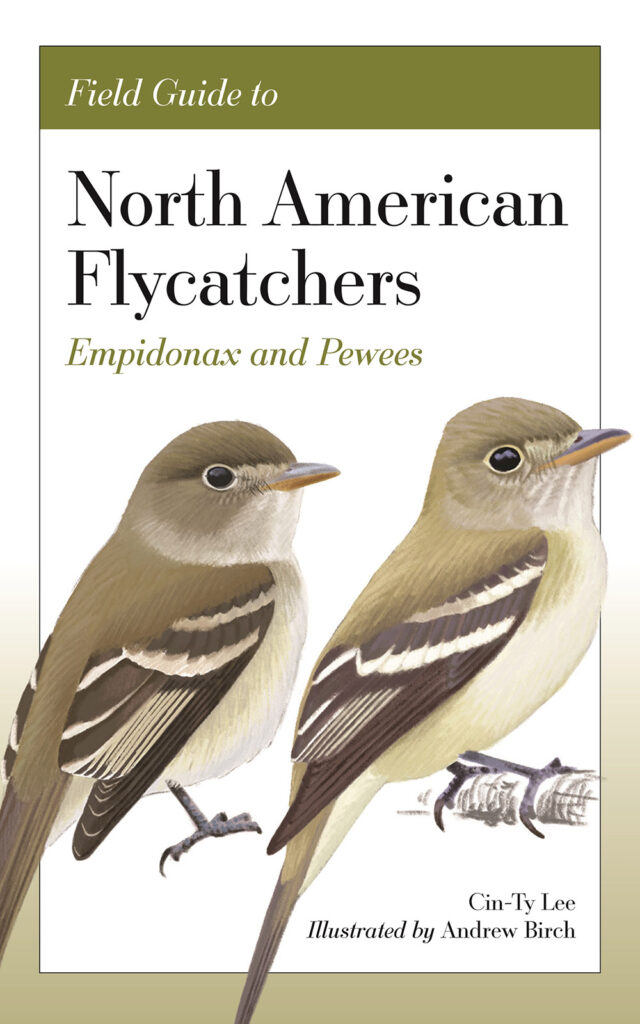Field Guide to North American Flycatchers: Empidonax and Pewees. Cin-Ty Lee and Andrew Birch. 2023. Princeton University Press, Princeton, NJ, USA. 168 pages. ISBN 9780691240626. Paperback ($19.95).

For many North American birders and ornithologists, the field identification of Empidonax flycatchers and their pewee cousins has long been one of the most difficult ID puzzles. Over the past six decades a range of top museum specialists, banders, and birders have spilled considerable ink on the subject in the scientific literature, field guides, and magazine articles, but this book is the first field guide to focus specifically on this often-perplexing group of flycatchers.
The book covers all Empidonax and pewees that occur in North America north of Mexico, as well as their close taxonomic relative, the Tufted Flycatcher. The first third consists of illustrated explanations of the terminology used in the ID characteristics, vocalizations, and range maps, with the species accounts taking up the remainder of the book. The introductory section includes eleven physical characteristics ranging from well-known field marks like eyering shape to more esoteric criteria such as strength of contrast between the pale edges of the secondaries and the darker primaries. There are brief primers on voice, including the shapes shown on spectrograms of the calls and songs; habitat preferences; and the distribution maps, which show spring and fall migration routes and expected timing in multiple locations. The art is quite good and takes particular pains to show comparisons of similar species in a variety of postures and angles so as to highlight their differences. Several species accounts include illustrations grouping often-confused species and the key ID criteria for distinguishing them.
The arrangement of the spring and fall migration maps and the accompanying bar charts is slightly confusing, as at first glance it appears that the bar charts are meant to refer to the respective seasons. It may have been better to group all the bar charts together without the lines indicating exact localities – the timing information within them is likely applicable to relatively broad areas. The range maps are also a little inconsistent. Some of the western species maps show incredible detail that illustrate the different mountain ranges and basins in which they do or do not occur. However, others, such as Yellow-bellied Flycatcher, show large gaps in locations where the species breeds, and at least the Eastern Wood-Pewee map shows the winter range as including areas where lingering migrants have been recorded in December.
Aside from those hiccups the maps are accurate and helpful. I particularly appreciated the isobar-style lines showing expected spring and fall arrival dates, and the emphasis on the different routes that species can and do take in the different seasons; this is one of the few field guides to highlight elliptical migration paths, which is an underappreciated aspect of species’ distributions.
Many of the field marks mentioned in the book can be difficult to see in the field depending on the angle and mood of an individual bird, and some such as forehead angle can be a subjective judgement call, but other marks such as differences in wingbars seem to be right on the money. I went through a number of photos in the Macaulay Library to assess the wingbars between Eastern and Western wood-pewees, and Least and Hammond’s flycatchers, and the book holds up well.
With all of the different field marks the book focuses on, I was a little surprised that there was no mention of how Acadian Flycatcher has pale gray legs while other Empidonax have black legs, or that the juvenile plumage of Acadian Flycatcher is unique in having obvious buff edges, which creates a “scalloped” appearance that lasts until they molt. The molt section had a few minor inaccuracies, but this is a dry and very technical topic not necessarily suited for the sort of general audience the book is aiming for. The basic information on how some species are more likely to appear worn in the fall is all the book really needs on the subject of molt. Overall, this book does exactly what it sets out to do and is a solid addition to the niche of field guides focused on particular groups of species, although it may be more useful out of the field than in the field. The information and illustrations are a useful study guide for brushing up on both the overall impression of these flycatchers, as well as all the little details that go into identification, and it will be an incredibly handy tool for anyone looking to ID photos after a day in the field. A particular valuable use I see for it is in helping explain the fine points of identification to beginning and intermediate birders. As an eBird reviewer I already know that I’ll be pulling this book off the shelf on a regular basis during migration as I write up yet another email about a misidentified flycatcher photo.
Blaine Carnes
Researcher
Header photo: Eastern Wood-Pewee (Contopus virens), Grayson Smith/USFWS
Suggested citation:
Carnes, B. Review of the book Field Guide to North American Flycatchers: Empidonax and Pewees by Cin-Ty Lee and Andrew Birch. Association of Field Ornithologists Book Review. https://afonet.org/2023/04/field-guide-to-north-american-flycatchers-empidonax-and-pewees/.
If you are interested in contributing a book review, or if there is a book you would like to see reviewed on our site, you can contact our Book Review Editor, Evan Jackson at evan.jackson@maine.edu
